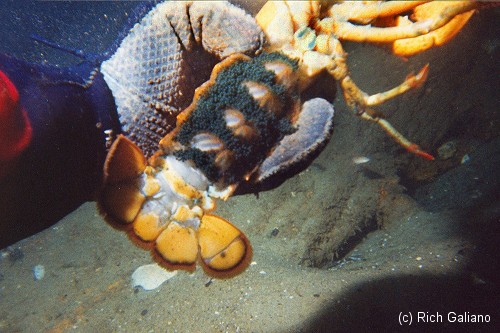Lobstering

This is what it's all about. Well, for some folks anyway. Yet, I have seen many beginners totally frustrated in their attempts to catch their first 'bug'. Perhaps these pointers will help:
Lobsters haven't evolved much in the last twenty years, but lobstering sure has. For one thing, bugs are a lot fewer and a lot smaller, unless you go way out deep. For another, the regulators took away our trophies with a maximum size limit, and they've also added seasonal closures. Not that I won't grab a nice bug if I can, but lobsters are not the same game they used to be, and not my motivation in diving.

A Word on Poaching
Catching lobsters is great sport, but one should not forget that that is exactly what it is - a sport. Using gaffs, gigs, hooks, spears, mechanical grippers, and noxious chemicals to get the beasties out of their holes is not only illegal, it is immoral, unethical, and unsporting. Remember - if you lose, you can always go buy one at the store; if it loses, it's dead.
It is illegal to possess more than two claws per tail. In other words - no parts. The minimum size for a lobster is listed in the regulations section of this website; at least as of the last time I updated the website. Any lobster that is smaller than the legal limit must be released unharmed.
However, the worst offense of all is the taking of female lobsters with eggs. Even when the eggs are stripped off in the water by the poacher, it is fairly obvious what has been done and will neither fool anybody nor make it alright. There is simply no excuse for this reprehensible act, which destroys not only a breeding adult lobster, but generations of offspring as well.

New Jersey is the last state in the northeast that allows recreational lobstering without a permit, a daytime-only rule, or a season. Abuse of this privilege, in the long run, can only result in new restrictions and regulations that will ruin the sport for all of us. Observe the regulations for lobstering, and if you see illegal poaching, don't turn a blind eye, do something about it.
That's it, I'll get off the soapbox now, except for one more thing: As you put that prized 20-pound bug in your cooler for its final trip to the boiling pot, remember that it may have been around longer than you have. I'll admit I've never had this dilemma, but if I did, I think I would rather have a picture, and then release the old giant where no one else will find it, so that it could go on producing baby lobsters for years to come. This is really not hard to do - simply drop it overboard in the middle of nowhere on the way back to port.







